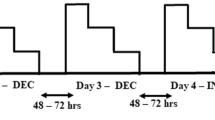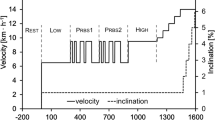Summary
In order to evaluate changes in parameters at the ventilatory threshold (VT) and in mechanical efficiency (ME) during training in the years 1982 and 1983 we tested seven top-class endurance runners on a treadmill. The VT and ME were assessed during their training period (January 1982 and 1983) and during their competitive period (March and July 1982). The maximal functional variables were almost constant during the training year, the maximal change in\(\dot V_{{\text{O}}_{{\text{2}} {\text{max}}} } \) being about 5%. Similarly,\(\dot V_{{\text{O}}_{\text{2}} } \) at the VT was almost constant; the maximal change in\(\dot V_{{\text{O}}_{\text{2}} } \) at VT was also about 5%. Substantially greater changes, about 10%, were recorded in the velocity of running at the VT, at which the maximum was attained in July (18.9±0.8 km·h−1 or 5.25±0.22 m·s−1); this value was significantly higher than values assessed during the remaining tests. The greatest change, about 23%, during the training year was found in ME, for which the maximum was attained in July (35.7%±2.1%). This was not significantly different from the value recorded in March (34.5%±3.3%), but both values were significantly higher than those recorded during the training period. We can therefore conclude that in highly trained endurance runners the times needed to attain the optimal conditions for sports performance differ from the point of view of special speed training and from the point of view of mechanical-metabolic readiness.
Similar content being viewed by others
References
Brooks GA (1985) Anaerobic threshold: review of the concept and direction for future research. Med Sci Sports Exerc 17:22–31
Bunc V, Šprynarová Š, Heller J, Zdanowicz R (1984a) Possibilities of application of anaerobic threshold in work physiology: II. Methods of determination of anaerobic threshold (in Czech). Prac Lék 36:127–133
Bunc V, Šprynarová Š, Pařízková J, Leso J (1984b) Effects of adaptation on the mechanical efficiency and energy cost of physical work. Hum Nutr Clin Nutr 38C:317–319
Bunc V, Heller J, Šprynarová Š, Zdanowicz R (1986) Comparison of the anaerobic threshold and mechanical efficiency of running in young and adult athletes. Int J Sports Med 7:156–160
Bunc V, Heller J, Leso J, Šprynarová Š, Zdanowicz R (1987a) Ventilatory threshold in various groups of highly trained athletes. Int J Sports Med 8:275–280
Bunc V, Heller J, Leso J (1987b) Coefficient of energy demands of running (in Czech). Čas Lék Čes 126:854–857
Costill DL (1979) A scientific approach to distance running. Track Field News, Los Altos, pp 23–64
Davis JA, Frank MH, Whipp BJ, Wasserman K (1979) Anaerobic threshold alterations caused by endurance training in middle-aged men. J Appl Physiol 46:1039–1046
Davis JA (1985) Anaerobic threshold: review of the concept and direction for future research. Med Sci Sports Exerc 17:6–18
Denis C, Fouquet R, Poty P, Geyssant A, Lacour JR (1982) Effect of 40 weeks of endurance training on the anaerobic threshold. Int J Sports Med 3:208–214
Dudley GA, Abraham WM, Terjung RJ (1982) Influence of exercise intensity and duration on biochemical adaptations in skeletal muscle. J Appl Physiol 53:844–850
Gaesser GA, Poole DC (1986) Lactate and ventilatory threshold: disparity in time course of adaptation to training. J Appl Physiol 61:999–1004
Grimby G, Saltin B (1971) Physiological effects of physical training. Scand J Rehabil Med 3:6–14
Hartley LH, Grimby G, Kilbom Å, Nilsson NJ, Åstrand PO, Bjure J, Ekblom B, Saltin B (1969) Physical training in sedentary middle-aged and older men. III. Cardiac output and gas exchange at submaximal and maximal exercise. Scand J Clin Lab Invest 24:335–344
Henricksson J, Reitman JS (1976) Quantitative measures of enzyme activities in type I and type II muscle fibers of man after training. Acta Physiol Scand 97:392–397
Henritze J, Weltman A, Schurrer R, Barlow K (1985) Effects of training at and above the lactate threshold on the lactate threshold and maximal oxygen uptake. Eur J Appl Physiol 54:84–88
Hurley B, Hagberg J, Allen W, Seals D, Young J, Cuddihee R, Holloszy J (1984) Effect of training on blood lactate levels during submaximal exercise. J Appl Physiol 56:1260–1264
Jones N, Ehrsam R (1982) The anaerobic threshold. Exerc Sport Sci Rev 10:49–83
Komi PV, Ito A, Sjödin B, Wallenstein R, Karlsson J (1981) Muscle metabolism, lactate breaking point, and biochemical features of endurance running. Int J Sports Med 2:148–153
Poole DC, Gaesser GA (1985) Response of ventilatory and lactate threshold to continuous and interval training. J Appl Physiol 58:1115–1121
Prampero PEdi, Atchou G, Brückner JC, Moia C (1986) The energetics of endurance running. Eur J Appl Physiol 55:259–266
Rusko H, Rahkila P, Karvinen E (1980) Anaerobic threshold, skeletal muscle enzymes and fiber composition in young female cross-country skiers. Acta Physiol Scand 108:263–268
Sjödin B, Jacobs I, Svedenhag J (1982) Changes in onset of blood lactate accumulation (OBLA) and muscle enzymes after training at OBLA. Eur J Appl Physiol 49:45–57
Stuart MK, Howley ET, Gladen LB, Cox RM (1981) Efficiency of trained subjects differing in maximal oxygen uptake and type of training. J Appl Physiol 50:444–449
Whipp BJ (1983) Ventilatory control during exercise in humans. Annu Rev Physiol 45:393–413
Yoshida T, Suda Y, Takeuchi N (1982) Endurance training regimen based upon arterial blood lactate: effect on the anaerobic threshold. Eur J Appl Physiol 49:223–230
Author information
Authors and Affiliations
Rights and permissions
About this article
Cite this article
Bunc, V., Heller, J., Moravec, P. et al. Ventilatory threshold and mechanical efficiency in endurance runners. Europ. J. Appl. Physiol. 58, 693–698 (1989). https://doi.org/10.1007/BF00637378
Accepted:
Issue Date:
DOI: https://doi.org/10.1007/BF00637378




